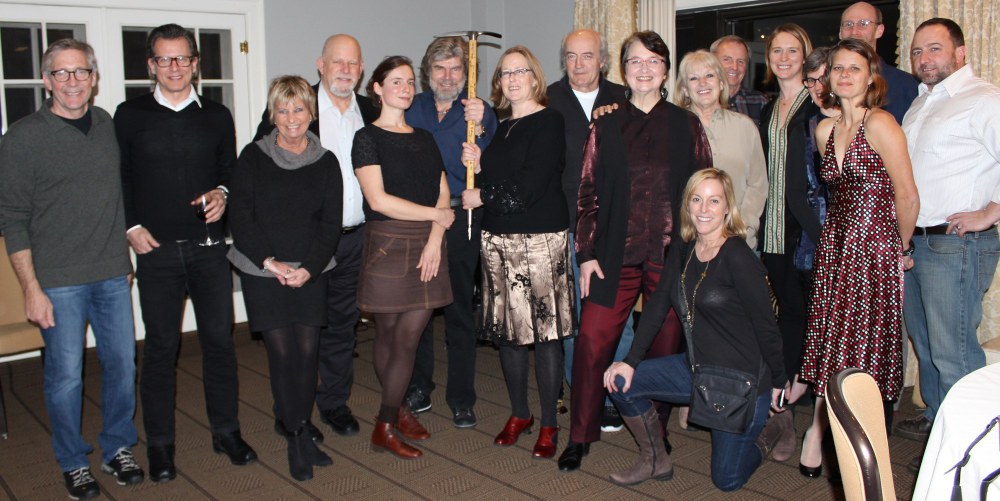
It may sound odd, but Reinhold Messner has been inside my head for more than two decades. His deeds, his remarkable introspection, and his sheer productivity set him in a class all his own. In addition to climbing the fourteen 8000-meter peaks, crossing Antarctica and the Gobi Desert on foot, and researching the roots of the Yeti, he has written some sixty books. I’m proud to note that Mountaineers Books has published translations of fourteen of those books, making us his publisher of record in North America.
But what is Messner doing in my head? It was some years ago when we published the first edition of Free Spirit and we had the job of designing the cover that I began to think of Messner in a different way. The editor and I were not at all excited by the thought of yet another mountaineering book cover featuring a silhouetted climber in a spidery pose on an impossibly vertical rock with a brilliant blue sky--that allowed room for the title—behind. (Option B would be identical but substitute a menacing gray sky). Couldn’t we move beyond representing the accomplishment to reveal more about the character behind the action?
As we went through his handful of portraits, we believed that by stripping everything down to a close up of his face, eyes, expression—we could get closer to reflecting his resolve, and reveal the measure of this man. Going all in, we decided to put a splash of red on the cover—so it would stand out on a seller’s book shelf among its blue and gray neighbors: a poppy in a field of sage.
I’m happy to report that the book did well.
There is a strong cerebral and creative streak in Reinhold Messner’s life that sets him apart as bluntly as his boundary-shifting achievements (and, I like to think, as our cover distinguished Free Spirit from its neighbors). He is both a chronicler and an ambassador for the mountains that are core to his existence.
We can explore his world through his narratives, and also in the artistry of his Messner Mountain Museums. It is through these five—soon to be six—museums constructed in South Tyrol in the landscape of the Dolomites that Messner brings the pulse of the mountains alive. 'Holy Mountains', he calls them. “Creation is the strongest possibility to express ourselves,” he believes. The museums, like the man, are unpredictable, unexpected, and transcendent. They are revelations to me—and I have only visited them through intriguing images in a coffee table book—written in German—a language I am completely unfamiliar with.
Picture an ancient crumbling castle—renovated with the addition of an airy glass roof hovering over the ancient ruins. At another museum, a glass structure, leading into a renovated fort atop a mountain with breathtaking views. In these museums, we don’t find dusty cases of maps and crampons and bits of rope documenting his over 3000 ascents—these museums are alive with Buddhist art, and contemporary sculpture that bridges history, thought, and landscape. Exhibits and artifacts reveal the science of mountains and glaciers, the history of mountaineering, rock climbing, and mountain people. It is unpredictable, unexpected—and transcendent.
Dining with Greatness
The night before his recent public event in Seattle, while a few members of our Legends and Lore Founders Circle, some Mountaineers staff, and the team from adidas outdoor enjoyed an intimate dinner with Reinhold, I became aware of something else that sets him apart. Reinhold’s approach to his accomplishments, like the accomplishments themselves, is personal, not a blueprint to be followed by others.
At this dinner, Eric Linxweiler, vice president of publishing for Mountaineers Books, asked Messner what advice he would give to young people learning to climb today. His answer surprised me.
“I would have no advice for them.”
Messner elaborated on the importance of finding a personal style to suit one’s philosophy and temperament. What was right for him was not necessarily right for others; young climbers today should form their own dreams and act in accordance with their own beliefs. He explained that, personally, what mattered was that his adventure be difficult, dangerous, and with significant exposure. “A climb is not ‘possible or impossible.’ And after age fifty, it is not about right or wrong.”
He remains committed to the idea of “by fair means,” with little between him and the mountain: light alpine style, minimal gear, unsupported by porters, difficult routes. “It would be better to do a 6000-meter peak by fair means than Everest with help.”
My most treasured memory from this visit is perhaps when Reinhold Messner placed a copy of his most recent book, Uberleben, into my hands and said, “Perhaps you might be interested in taking a look at this. . . ”
When he came earlier this month, it had been many years—more than twenty —since his last visit to Seattle. At his talk on February 2, he promised to be back again sooner than that—and to climb Mount Rainier on his next visit.
 Helen Cherullo
Helen Cherullo